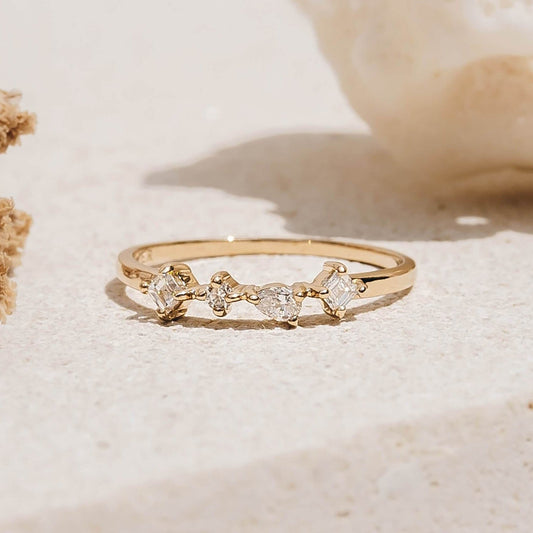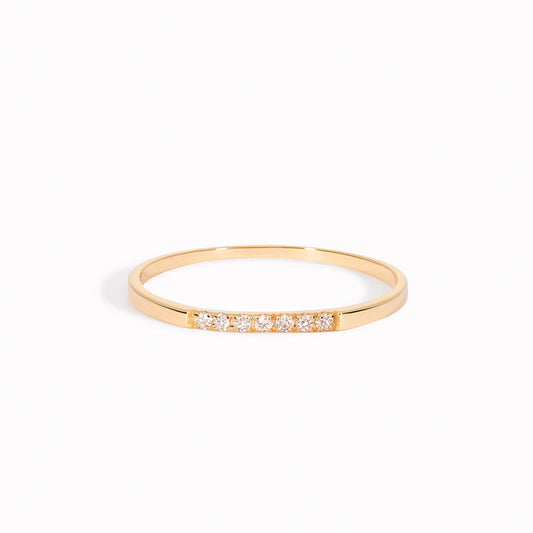Lab Grown Diamonds: Your Complete Guide | Linjer Jewelry
What are lab grown diamonds?
Lab grown diamonds are diamonds that are created in laboratories by replicating the heat and pressure that is used in forming earth-mined diamonds. Just like earth-mined diamonds, lab grown diamonds are made from 100% pure crystallized carbon, and they are chemically, physically, and visually identical to earth-mined diamonds. While scientists have experimented with growing diamonds for many years, it’s only been in the last 10 years or so that the technology has been perfected.
It’s incredible that such a precious and transparent gemstone is made of the same dark stuff found in those yellow No.2 pencils we used at school. Even more incredible is that something produced in nature millions of years ago 150 kilometers below the earth’s surface can take place today in a laboratory in a matter of weeks.
How are lab grown diamonds made?
Lab grown diamonds are made or grown using diamond seeds, carbon, and a diamond growth chamber. As technical as it might sound, the process is quite straightforward. For starters, the diamond seed is a hair-width slice of a natural diamond. The chamber is a sealed environment that is able to create one of two processes: HPHT or CVD.
The High-Pressure High-Temperature process has been around since the 1950s and is just what it sounds like. The seed is placed in solid carbon, which becomes molten and eventually adheres to and crystalizes upon the diamond seed.
Chemical Vapor Deposition, a technology from the 1980s that’s been refined in the last few years, turns carbon-rich vapor into plasma, which deposits the carbon atoms, like falling snowflakes, over the diamond seed. This technology is able to produce diamonds that are free of contaminants—a class of diamonds rarely found in nature.
Shop Lab-Grown Diamond Jewelry
14k Yellow Gold Diamond Huggie Earrings - Susanna |
Diamond Ring - Ilse Luxe |

See Product |

See Product |
14k Yellow Gold Diamond Stud Earrings 3mm - Aria |
Diamond Eternity Ring |

See Product |

See Product |
What are the benefits of lab grown diamonds?
The benefits of lab grown diamonds include high quality, reduced environmental impact, lack of labor concerns, and overall increased accessibility for wearers.
- Quality. One benefit of CVD diamonds is that the stones produced are of a purity and class rarely found in nature. These diamonds are called Type IIA. They are free of nitrogen, boron, and other impurities that can be found in natural and HPHT diamonds, and they have the highest brilliance, transparency, symmetry, and thermal conductivity.
- Sustainability. Another benefit of lab grown diamonds is the environmental factor. Natural diamonds are a limited resource, and the methods used to extract them are increasingly invasive. Lab grown diamonds, on the other hand, are friendly towards ecosystems, wildlife, and habitats, and the materials used are much less likely to be exhausted in the long term.
- Ethicality. Some diamond mining companies have a history of child labor and funding political violence, and while conflict-free natural diamonds exist, there is a lack of confidence in the enforcement of those standards. Lab grown diamonds are considered an ethical and conflict-free alternative.
- Accessibility. Conflict-free lab grown diamonds are more accessible to the general consumer. The same characteristics found in natural diamonds that cost thousands (even millions) of dollars due to their scarcity and cost of production can be grown in the lab at a fraction of the cost. Now, many diamond lovers can enjoy colors, cuts, and carats that were once out of reach.
What are the disadvantages of lab grown diamonds?
Some disadvantages or concerns surrounding lab grown diamonds include their sentimental value, market value, energy use, and economic impact on certain communities.
- Sentimentality. As lab grown diamonds take on some of the characteristics of their seed, each one is unique. Still, some think that a lab grown diamond won’t have the same allure as a natural diamond.
- Energy use. Lab diamond production is an energy intensive process although increasingly, lab diamond producers are optimizing their processes to reduce energy consumption.
Are lab grown diamonds conflict-free?
Yes, lab grown diamonds are 100% conflict-free! As lab grown diamonds are produced in a controlled environment (the lab!), there is no possibility of them being associated with human rights abuses or financing of armed conflicts in mining areas. In contrast, the mined diamond industry still faces challenges in completely cleaning the market of blood diamonds. Despite recent commitments to improve transparency and traceability with initiatives like the Kimberley Process, the earth mined industry still has a long way to go.
Lab grown diamonds are the preferred choice for conscientious jewelry wearers. Linjer chooses to buy only lab grown diamonds so that we can guarantee that we are not contributing to wars and funding warlords!
Are lab grown diamonds a good investment?
Lab grown diamonds are a good investment for a conscious gemstone consumer looking to add beautiful, high-quality gemstones to her collection without the environmental and labor concerns associated with traditionally mined diamonds. The value of all gemstones is given to a certain measure of volatility, and as the lab-grown industry is up-and-coming, we’ve yet to see how lab grown diamonds will perform as a financial investment over time.
That said, as a personal investment, due to their competitive pricing, lab grown diamonds open a wide array of options in terms of purity (clarity), size (carat), cut, and color, characteristics which are not as accessible with traditionally mined diamonds.
Are lab grown diamonds valuable?
Lab grown diamonds are valuable. The value varies in terms of a few important characteristics. In fact, these are the same characteristics used to classify natural diamonds: that is color, cut, clarity (or purity), and carat (or size).
- Color. The closer a stone comes to being colorless, the higher the grade, and CVD diamonds score very well in this category. Also, fancy colors are graded by hue, tone, and saturation. Lab grown diamonds offer many more options in terms of fancy colored diamonds.
- Cut. Fire, brilliance, and scintillation all come into play with the cut. The uniform shape and lack of imperfections in lab grown diamonds make it easier for cutters to achieve high-scoring round cuts and highly sought fancy cuts.
- Clarity. Because lab grown diamonds are created in a controlled environment, impurities and inclusions are very infrequent, and lab grown diamonds frequently score very well on the flawlessness scale. Though it’s important to note that flawlessness is quite rare, even with lab grown diamonds.
- Carat. HPHT diamonds can grow as large as 10 carats and CVD as large as 9 carats. That said, lab grown diamonds are typically sold between 1 and 3 carats.

Are lab grown diamonds flawless?
No, lab grown diamonds are not flawless. A flawless diamond is defined as having no visible inclusions or impurities, even under 10x magnification. And, even in controlled growing conditions, flawlessness is next to a miracle. Still, CVD lab grown diamonds are highly praised for their very high clarity grades. HPHT diamonds are slightly more susceptible to metallic inclusions and exposure to nitrogen.
CVD diamonds are usually graded as Type IIA diamonds, meaning they have no measurable nitrogen or boron impurities. They are usually colorless and are chemically the purest.
Do lab created diamonds get cloudy?
While HPHT lab grown diamonds can take on a cloudy appearance due to nitrogen exposure, CVD diamonds rarely get cloudy, and in fact, as Type IIA diamonds, they are classed as the highest standard in brilliance and transparency.
CVD diamonds don’t get cloudy due to the nature of the technology used to produce them. The diamond growing chambers are vacuum sealed and kept free from contaminants. If there is some cloudiness, lab grown diamonds are usually further refined in a post-growth treatment that removes any initial cloudiness.
Can you insure lab created diamonds?
Yes indeed, lab grown diamonds can be insured. Different insurance companies will have different offers. Gemstone insurance can sometimes be tacked on to homeowners insurance. And, in general, gemstone insurance should cover loss, theft, and damage. The premium and deductible will depend on the stone’s certification, grade, purchase price, and appraisal. You should expect to pay anywhere from 1-3% annually for lab grown diamond insurance.
What does it mean if my lab diamond Is treated?
Treating a lab grown diamond means subjecting it to a high heat treatment (after its initial growth) in order to improve the quality and appearance. Many, though not all, lab grown diamonds (both CVD and HPHT) receive post-growth treatment.
Just like with natural diamonds, the purpose of treatment is to enhance quality and appearance. However, unlike natural diamonds, treatment for lab grown diamonds is a standard process and does not diminish their value. Post-growth diamond treatment is also used on lab grown diamonds to achieve a range of luxury colors like pink, yellow, and blue.
Shop Lab-Grown Diamond Jewelry
Diamond Solitaire Ring |
14k Yellow Gold Diamond Stud Earrings - Trillium |

See Product |

See Product |
14k Yellow Gold Diamond Bar Stud Earrings - Lucia |
Diamond Pave Band - Miriam |

See Product |

See Product |
How long do lab grown diamonds last?
Just like traditional diamonds, lab-grown diamonds last forever… as the saying goes. Lab grown diamonds are chemically and physically equal to traditional diamonds. A common comparison or analogy is ice. Whether produced in a freezer or on a lake, ice is ice. In the same way, diamonds are diamonds, whether formed in the earth’s crust or in a lab. And, given that diamonds are the hardest substance on the planet (ranking 10/10 on the Moh’s scale), they are virtually indestructible. With enough applied force, you can chip or crack a diamond (we wouldn’t be able to cut them otherwise), but you’d really have to go out of your way to achieve it.
Should I buy lab grown diamonds?
Whether or not you should buy lab grown diamond ultimately depends on your preferences. Some people who find a lot of sentimental value in earth-mined diamonds may prefer to buy mined diamonds.
Buy lab grown diamonds if your reasons include:
- Conscious consumption is one of your core values. Lab grown diamonds have the potential to offer more security when it comes to ethical purchases. These diamonds are conflict-free and less invasive to the environment and local ecosystems.
- Making a personal and aesthetic investment for your jewelry collection. Lab grown diamonds offer a wide range of exciting, top-quality options for jewelry wearers at a much more accessible price. Expect to spend 50-75% less on lab-grown diamonds of equal quality.
- The clarity, brilliance, and cut of the diamond matters to you. Lab grown diamonds grade exceptionally well in terms of brilliance and clarity. Due to their symmetry and uniformity, cutters can routinely choose fancy cuts—like the princess cut—that are much more expensive with natural diamonds.
- You want to add a fancy colored diamond to your collection. High-quality fancy colored diamonds are hard to come by in nature while many luxurious colors are easily obtained with lab grown diamonds.
Discover Linjer's Lab Grown Diamond Jewelry
Find the perfect lab grown diamond rings for celebrating your Big Moments (think “I do!”), as well as unique designs that will make every day feel special.
Of course, in true Linjer style, our Diamonds Collection comprises luxury quality without the luxury markup, meaning that every piece is fairly priced, making it easier and more affordable to treat yourself and your loved ones, all while being kinder to the earth.








